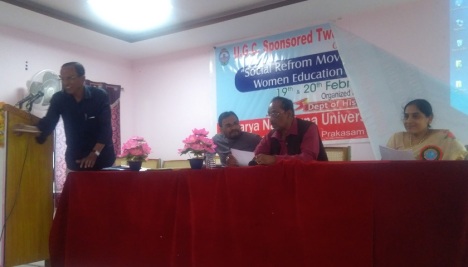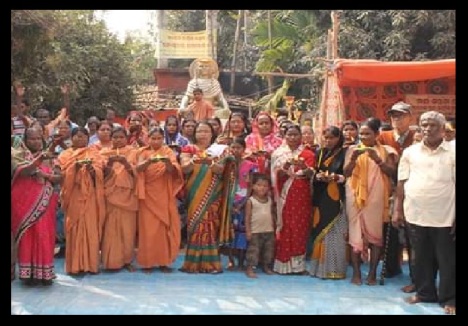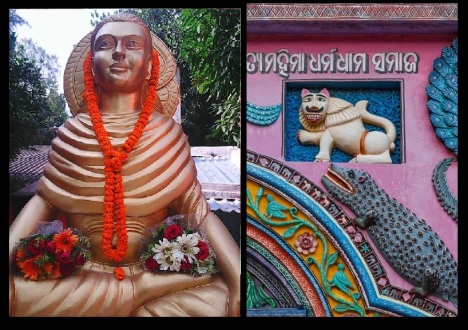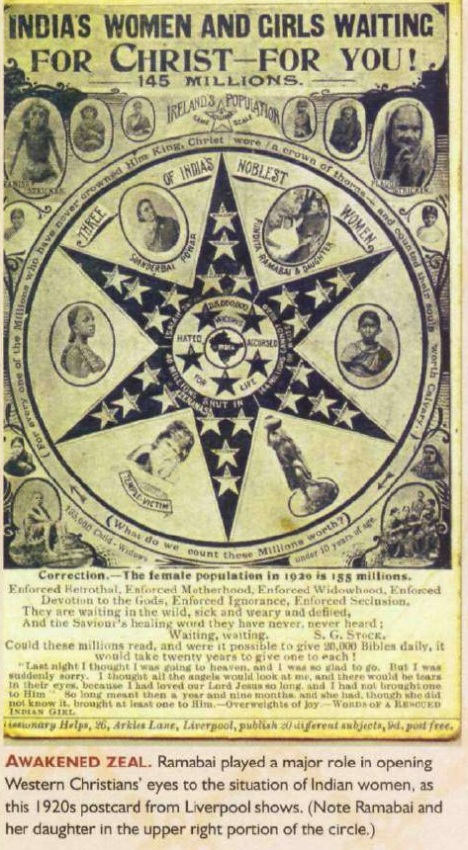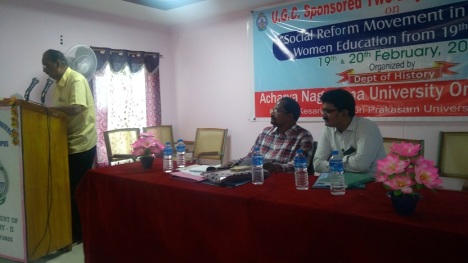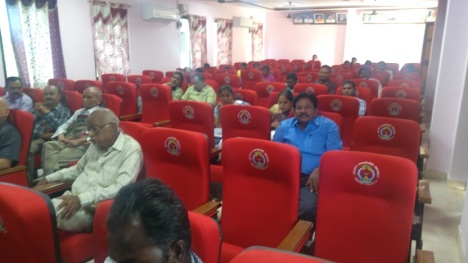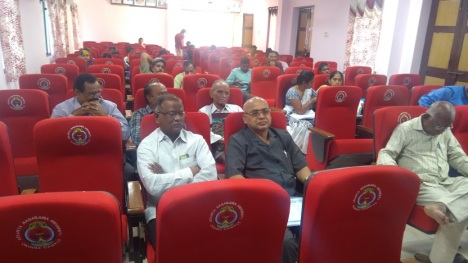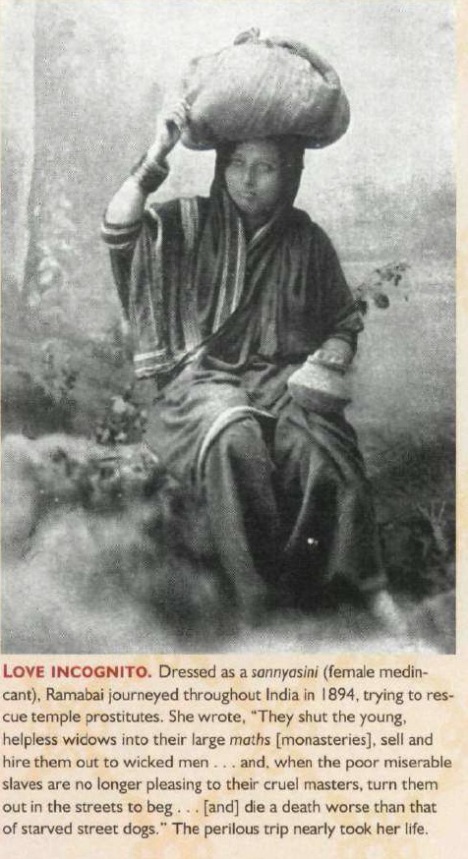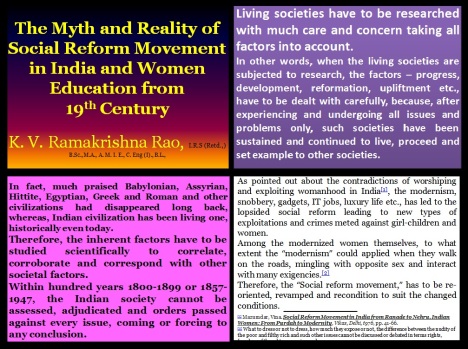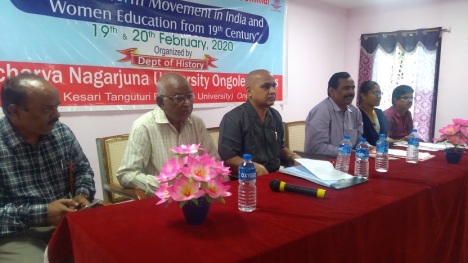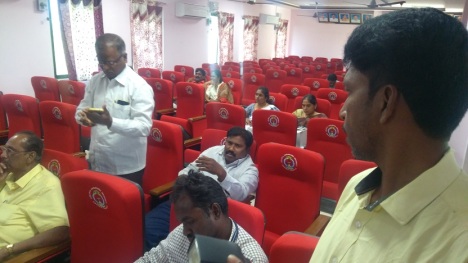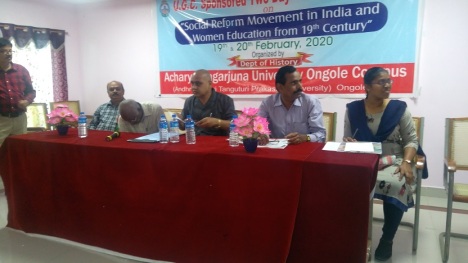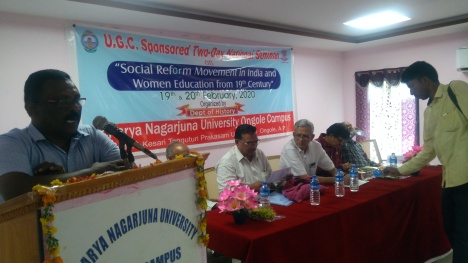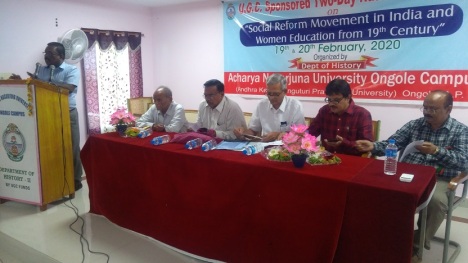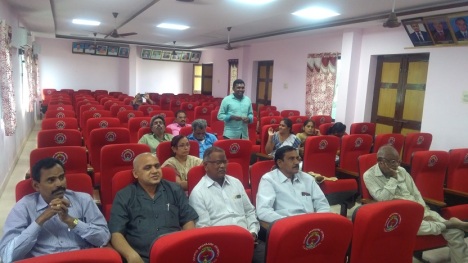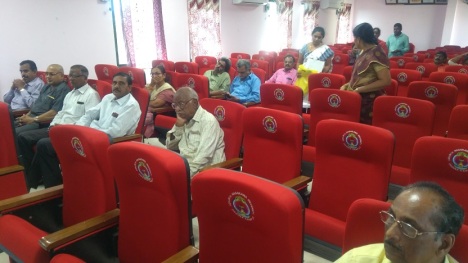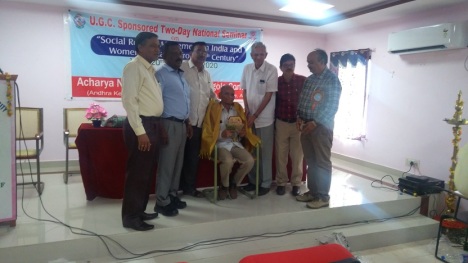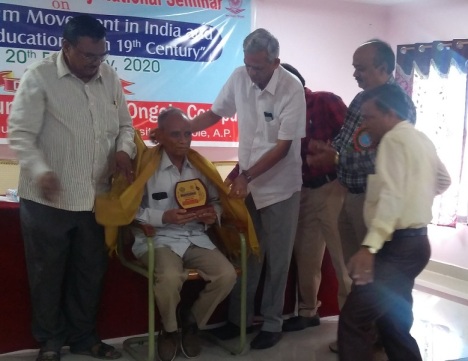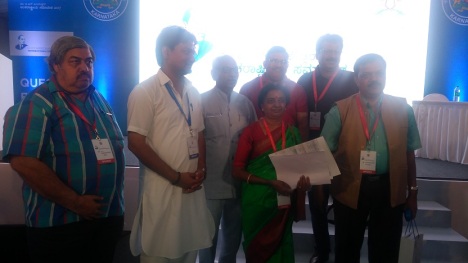The Proceedings of the 39th session of Andhrapradesh History Congress held at Sree Potti Sriramulu Telugu University, Srisailam campus on January 31st and February 1st 2015

1. Srisailam location, map at APSRTC bus-stand, Srisailam
The Campus of Sree Potti Sriramulu Telugu University is situated opposite to Shivaji Spoorty Kendra: For the delegates who were coming from other states or from Chennai, Pondicherry, Chittoor and other places, reaching Srisailam had been a tedious journey involving more than 12 to 16 hours road journey, unlike for those who were coming from Hyderabad, Warangal, Kambam, Ongole etc. Most of the people at Srisailam did not know the location of the Campus of Sree Potti Sriramulu Telugu University (hereinafter mentioned as PSTU). Had the organizers mentioned that it was situated just opposite to Shivaji Spoorty Kendra, it would have been easier for the delegates to reach. From temple side, the hilly areas were leveled by Boukline machines on 30th, when I was walking up to locate the venue of the 39th session of APHC. When I reached after enquiring from many people, the place looked like deserted one. As there were two wheelers and three cars, I assumed that there were people inside the building. Of course, the Dean Sri Appa Rao, the local secretary, Pasala Sudhakar Rao, General Secretary of APHC and other staff members were there. I could meet Drs Chandrasekara Reddy, Babu Rao and others also. I was informed that the proceedings would be held there only.

1. Ganga sadan where I stayed on 30th and 31st January 2015
Ganga Sadan is the central Reception office of the Srisailam Devasthanams, where rooms are allotted for the devotees coming to Srisailam. Rooms can be booked online also.

2. The junction – temple LHS- APSRTC RHS
This the junction, from where we can go to the Temple on LHS road, APSRTC bus-stand on RHS and Patalaganga straight.

3.The street leading to the temple
The road on LHS leads to the main temple and it is dotted with many shops on either side. Of course the Chatrams / Pilgrimage staying Houses are there behind.

3. Temple dwajastambam
The Dwajastambam / flag-mast at the entrance of the temple can be seen.

4. Dwajastambam and nandi
The Dwajasthambam and Nandi – closer view. For PSTU, we have to go on the RHS road.

5. srisailam temple entrance
The temple entrance, photography is prohibited thereafter.

6. Going to University campus-the temple gopuram and wall can be seen
The RHS road leads to PSTU and I started walking slowly enquiring. The road is rocky and it is levelled.

7. Going through the road-getting levelled on that day
How the road is levelled.

8. Gangabhawani vapaharanamu- on the way to PSTU
“Gangabhawani Vapaharanamu”, Siddharameswaram Sawmy Paddalu, Koneru, Mallannapada Darshana place, and many guest houses could be seen on the way. There have been many gust houses built by the private and government companies, individuals etc on either side of the road, but looked deserted.

9. PSTU board – Shivaji Memorial can be seen on LHS
At last, I reached the road, where the name board of PSTU is there, but in Telugu. It is just opposite to the Shivaji Memorial and it can be seen on LHS.

2. view of PSTU from distance
View of PSTU from distance.

10. At last reached PSTU- on 30-01-2015
This the front side of the PSTU at Srisailam.

1. A. Appa Rao Local Secretary and P. Sudhakar General Secretary of APHC inside -30-01-2015
When I went inside, I could meet Prof / Dr A. Appa Rao Local Secretary and P. Sudhakar General Secretary of APHC in their room. They confirmed that the conference would held there only and preparations might start from the evening. After some time, I returned to Ganga sadan.
The Campus of Sree Potti Sriramulu Telugu University getting ready for the 31st session of APHC: The place can be reached from the right-hand side of the temple through a rough road. This route has been tedious for aged people above 60 or those who have problems with legs. “Gangabhawani Vapaharanamu”, Siddharameswaram Sawmy Paddalu, Koneru, Mallannapada Darshana place, and many guest houses could be seen on the way. Besides the accommodation provided by the Devasthanam , there have been many Choultries, guest houses etc., built and maintained by the Caste organizations. The delegates were accommodated in the Reddy Choultry opposite to Ganga Sadan, the Central Reception office of the Devasthanam and the APSRTC Bus-stand on the backside. As usual others were accommodated in different nearby and convenient locations, according to their choice or other modalities. On 30th night, the samiana / tent were put up and other arrangements were slowly made. Four rooms were marked for the ancient, medieval, historiography and local histories and the main podium samiana space for modern.
Inauguration on 31-01-2015 (Saturday): On the 31st, the registration counters were ready for the job as usual. The breakfast was delayed and the delegates could have it by 10 am and there were none to inform about anything. It was served upstairs on the backside of the building. The registration was also done. The inaugural invocatory recitals were rendered by the Pundit and students of the Virasaiva Gurukulam situated next to Shivaji Memorial and opposite to the campus. The inaugural session went on as usual with routine formalities of lighting the lamp (it was mentioned as “lamping the light” and then corrected[1]), handing over of charges, reading reports, garlanding the guests etc.

16. PSTU dedicated to – by NTR on 10-04-1986
The PSTU was dedicated …..by the former CM, N. T. Rama Rao on 10-04-1986, a Ugadhi day!

15. PSTU -dept.of history, culture-inaugurated on 8-2-1989
The School of History, Culture and archaeology was established in 1987, the building completed and inaugurated on 08-02-1989. At that time, the 13th session of APHC was hosted.

13. registration started on 31-02-2015
Registration of the delegates started on 31-01-2015 in the rooms situated on LHS after entering the campus.

14. Delegate fees collected -31
The delegate fees payment – Dr Chandrasekara Reddy can be seen.

17. Breakfast on 31-01-2015-10 am APHC
Breakfast served by the volunteers, Pongal and Vadai!

18. Breakfast on 31-01-2015-10 am -volunteers, APHC.
More volunteers…………………..

19. APHC office bearers relaxing before inauguration-31
APHC office bearers relaxing before inauguration, perhaps discussing also!

20.Inaguration-APHC
Inaguration function – K. Srinivasulu, B. P. Sahu, Adapa Satyanarayana, E. Siva Reddy, Tomas Ayya, G. V. Ramakrishna Rao, M. Venkateswara Rao.

21. Prayer by the Pundit and students of Veerasaiva Gurukulam-31st
Prayer by the Pundit and students of Veerasaiva Gurukulam, situated on RHS of the Shivaji Memorial.

22. Audience on 31st -inaugural session
Section of the audience on 31st -inaugural session RHS from the dais.

23. Audience on 31st -inagural session.LHS
Section of the audience on 31st -inaugural session LHS from the dais.
As per the printed invitation, Professors / Drs Adapa Satyanarayana would preside over, Pasala Sudhakar deliver and Elluri Sivareddy grace as chief guest and the guests of honours would be Sri / Prof / Dr Buddha Rajasekhar Reddy, MLA, Srisailam Constituency; P. Vidhyaprakash, VC in-chrge Rayalaseema university; K. Venkatachalam, Vice-charman, Telengana State Council of higher Education; K. Sagarababu, Executive Officer, Srisaila Devasthanam; and N. Narashimham, Dy Commissioner of commercial tax, Kadapa, but except Vijayaprakash none turned up and he also attended late.
Some delay for inauguration: Initially the inaugural function was held up, as the organizers were expecting the local MLA. Later, as there was power cut, it was delayed further. A. Appa Rao, K. Srinivasulu, B. K. Sahu, Satyanarayana, P. Sudhakar, E. Siva Reddy, Thomas Ayya, G. V. Ramakrishna Rao, M. Venkateswara Rao and A. Gurumurthy were on the dias and later Vijayaprakash joined. P. Sudhakar, in his report expressed his anxious that the organization should be protected to continue, as it was facing a crucial time. The local people or the people from Andhra might have understood what he was talking about, but, for the persons coming from other state, it was intriguing and perplexing.
- Siva Reddy[2] (11.36-12.48 pm): He pointed out that APHC session was hosted by the University for the second time. He would oppose to those who objected to the conduct of the conference there in Srisailam. Pointing out several lacunae in history writing, he said that Mahabharata could be story, but not Kakatiyas; origins of Satavahanas, Ikshvahus were stil in mystery; there were many gaps in history; culturally and traditionally all Telugu speaking people are one, but now divided; He asked as to whether history was to unite or divide people. Historians have to decide as to whether they are going to write Telengana history or Andhra history. History cannot be biased and historians should not entangled with the webs of ideology. “If we talk about Samprahaya, can we dubbed as RSS or VHP?”, he asked. Jains wrote their own Ramayana only to denigrate Rama, writing that Rama married his sister Sita. There should be academic honesty and not academic dishonesty. Many historians are writing histories without mentioning the sources or acknowledging the work done by others knowingly. Very often “Karnataka Sangeetham” is mentioned, but why “Karnataka” is mentioned is not explained.
Vijayprakash (12.00-12.48 pm: By that time as Vijayaprakash came, he was called to the dais. Excusing himself for coming delay, he also expressed himself that he had not come prepared with any paper. As history subject became redundant in the present-day context, historians should do something for it. As because of construction work and other infrastructure development works have been taking place, 6-track roads laid, the earth surface is continuously disturbed and many archaeological treasures are disappearing. As such activities would go on more and more I coming days, historians should pass an resolution and submit to the government that they should take concern about the archaeological evidences, in their digging activities, so that the evidences are not destroyed or vanished. Mentioning about the credit system introduced, he pointed out how Smriti Irani has made that even engineering and other professional students should taken subjects like history as optional subject[3].
Adapa Satyanarayana (12.49-12.22 pm)[4]: As a General presidential address, he started talking about conversion and activities carried on by the Christian missionaries. They used the Vemana’s writings against the Brahmanical Hinduism. He declared that his paper becomes relevance in the context of “Garvapasi” conversions talking place at the behest of the Hindutva forces under the present BJP government. He held that Mahatma Gandhi view about conversion exactly matches with the present-day Hindutva forces. However, Ambedkar differed from Gandhi. Ambedkar perspective reflects certain aspects of Marxian characterization of lower class religion as a potential vehicle for protest consciousness. He appreciated the excellent conversion work done by the Christian missionaries. He claimed that 80% dalits preferred to get converted to Christianity. In the Nizam dominion, there was never a communal riot, whereas, after that there communal riots, because of the Hindutva forces. According to Christian ideology, he declared that, “The Hindu way of life for caste and exclusiveness, the Christian way of life for catholicity and inclusiveness”. He deviated from his submitted paper (printed and circulated) and delved upon politicized controversial issues. It seems he has been in the habit of involved in such controversies[5].
Discussion with Adapa Sathyanarahyana: After his “reading of his paper”, I went to him and pointed out that the word “Dalit is neither legal nor Constitutional”[6], as the National commission for scheduled Caste pointed out and issued a Circular to that effect directing the states not use such expression[7]. The Soosai v. Union of India, AIR 1986 SC 733 judgment delivered by the Supreme Court[8], clearly pointing out the legal position that the SC benefit would not be available to the SCs, if they get converted to other religions other than Hindu, as per the Constitution. When we were discussing, suddenly V. Ramakrishna came and took him away, evidently to stop our discussion.
12.22 to 1.04 pm: The proceedings volume of 38th session was released by Sivareddy, followed by the “vote of thanks” as a matter of routine. Actually, it was announced that all should assemble back after a tea-break, but suddenly, when tea was taking, again it was announced that all go on for lunch. After lunch, the sessions were held as mentioned in the respective rooms.
| Sl. No |
Sectional President |
Prof / Dr |
| 1 |
Ancient India |
G. V. Ramakrishna Rao |
| 2 |
Medieval Andhra history |
K. Srinivasulu |
| 3 |
Modern Andhra history |
M. Venkateswara Rao |
| 4 |
Historiography |
B. P. Sahu |
| 5 |
Local History |
A. Gurumurthy |
The Mamidipudi Venkata Rangaiah Memorial lecture was delivered by Prof B. P. Sahu, New Delhi during the evening. This would be included in the proceedings volume to be released next year[9].
Valedictory function on 01-02-2015 (Sunday): Morning, the paper reading sessions continued. There were lively discussion about the papers presented. After lunch, the valedictory function was held. As per the printed invitation, the Valedictory function, Prof / Dr / Sri P. Apparao would preside over the function; Mandali Buddha Prasad grace as Chief Guest; and guests of honour G. Tatireddy, General Secretary, Ahhila Bharatiya Redla Sankshema Samakya; Immadisetti. Koteswara, All India Arya Vysya Anna satra Sangham; T. Rameshchandrabose, Kakatiya Kamma Sangham; and former deans – K. Thimma Reddy, D. Bhaskara Murthy, A. Gurumurthy, D. R. Raju, P. Chenna Reddy, R. Chandrasekara Reddy. After the function, the delegates started disbursing and going to bus-stand to reach t heir destinations.
“The Hindu” gives the politics behind the dilemma of the existence of “Sree Potti Sriramulu Telugu University” campus at Srisailam: Interestingly, “The Hindu” has given some details about the politics behind the dilemma of the existence of “Sree Potti Sriramulu Telugu University” campus at Srisailam. They are appended in the following paragraphs without changing any word. Only suitable captions have been given, that too, taking words and expressions from the news paper reports.
Widing up, watering down of and waging war for Srisailam centre[10]: The fate of Telugu University branch in History and Archaeology at Srisailam has been hanging in balance with the proposal to shift the Telugu University to Rajahmundry. According to reports, a high-level meeting of the Potti Sriramulu Telugu University at Hyderabad on 12-04-2014 (Wednesday) explored the possibility of shifting the University and its branches to Rajahmundry. The litterateurs and educationists who have been closely following the activities of the History Peetham at Srisailam sharply reacted to the development saying the spirit of the university was watered down by the bureaucratic professors of the university from time to time. Former Chief Minister N.T. Rama Rao envisaged the Telugu university to be located at Srisailam to offer courses in ancient studies in 1987. However, the bureaucrats changed it into three centres devoting the folk arts to Warangal, Telugu Peetham at Rajahmundry and history at Srisailam. But the head quarters of the University was located at Hyderabad. The university authorities were in dilemma with the bifurcation of the State. The head quarters and the Warangal centre might go the way of Telangana State, who would also rename the university deleting the prefix “Potti Sriramulu”.
The bureaucratic professors, professionally biased historians and others crearing problems: Several attempts were made in the past to shift the Srisailam centre to Hyderabad but the opposition from the local politicians forced the officers to drop the idea[11]. Another move was made to shift the centre to Kurnool on the ground that more courses could be introduced. Shifting of the centre to Kurnool had no much opposition. Educationist and socialite K.C. Kalkura who opposed the idea of winding up the centre said the Peetham should be shifted to Kurnool to be developed as university of Environmental and Ethnic studies while the existing facility at Srisailam should be used for accommodating the visiting students who need to stay at Srisailam as part of study of diversity of Nallamala forest. He said the policy makers should be careful in taking any decision in future knowing the fact the unequal development and unilateral way of functioning led to division of the state and such mistakes should not be done in future.
The responses appearing in “The Hindu” have been interesting: Venkat commented, “What a tragedy we are in. Splitting the place, splitting the people, splitting the culture and splitting the education system… What reasons are our so called leaders quoting? for better future!!! A future without unity can never be a role model. God forgive these interventionists or so called revolutionists for their historical blunder.”; raghu ram, “As major number of colleges and universities are there in and around Rajahmundry and Kakinada, it should be better to move Telugu University to West godavari district”; Ramadatta, “Not only Potti Sriramulu University but all those educational institutions started from 1956 onwards should be shifted to suitable
places in the residuary Andhra Pradesh urgently so that Telangana state can impart its rich history and cultural heritage like ‘bonalu, bathukamma’ the rule of Nizam and his ancestors under the guidance great academicians like Kodandaram. For Telangana people OU is sufficient to cater their needs in resorting to all types of hooliganism and pressure tactics and for academicians spending their teaching time for achieving their personal agenda.”:
Renaming of the University in the political game[12]: The Telangana government might soon issue orders changing the name of the Potti Sreeramulu Telugu University, in the aftermath of the State bifurcation. The names of Suravaram Prathap Reddy and Bammera Pothana are in the reckoning for renaming of the university soon after the division of assets and staff. Sources from the university seeking anonymity inform that the government is mulling the two names, with more emphasis on Suravaram Prathap Reddy, the renowned social historian, writer and father of the CPI’s National General Secretary, Suravaram Sudhakar Reddy. The name of Pothana, a much celebrated classical poet from Telangana, has surfaced to match with the spirit of Adikavi Nannaya University in Rajahmundry. The rechristening, if it happens, will be the second such for the university since its establishment in 1985. It was first named merely as Telugu University which was changed to Potti Sreeramulu Telugu University in 1998. The Vice-Chancellor of the university, E. Siva Reddy, however, said he was unaware of the name change proposals.
Bifurcation of the Andhra State or of Telugu people without caring for culture, tradition and heritage?: Nevertheless, division of the university is imminent, and clarity in this regard may be expected in a couple of months, he said. “It is as yet unclear how the division would be done, or how the assets would be distributed[13]. It may be done based on the geographical location of the respective schools associated with the university,” Dr. Reddy surmised. The university has 40 acres each in two locations of Andhra Pradesh, namely Rajahmundry and Srisailam, where the new headquarters for A.P. might come up after bifurcation. The university’s premises housing School of Classical Dance at Kuchipudi, School of History, Culture and Archaeology at Srisailam, and the School of Telugu Literary Studies at Rajahmundry might be allotted to Andhra Pradesh, while the School of Language Development, School of Fine Arts, and School of Social and Other Sciences, which are being run at the headquarters in Nampally, and the School of Folk and Tribal Lore in Warangal, may be retained by Telangana.
The responses appearing for this report in “The Hindu” have been interesting[14]. Jararam Jararam from POMPANO BEACH noted, “We now have two Telugu kingdoms!”; Helen from CARLISLE commented, “Renaming is not the solution. They need to work on the inferiority complex of the human mind before all these external ways of boosting their ego. These are just cheap tactics to show the power. One will not be surprised if the leaders of Telangana change their language from Telugu to some other name if they could. They could change whatever externally; let us see how they can change themselves internally. These cheap tactics will only alienate the others who are major contributors for the development of the region. Slowly, the whole area will come down….even if they call themselves living in Heaven.”; a.t.b.t.prasad from BANGALORE,” ‘bammera Pothana” is good for telugu university, hyd”; Gautham from AUDUBON, “The Hyderabad airport also must be renamed – to ‘Rani Rudrama Devi’ International Airport or ‘Kakatiya’ International Airport. All these years the name ‘Kakatiya’ got relegated to things related only to Warangal, while it was Kakatiyas who originally unified Telugu speaking kingdoms to give the identity we have today.”; JKM Rao from FREDERICK, “Though he passed away after fasting for the creation of the Andhra state, Potti Sriramulu was a freedom fighter, an ardent follower of the Mahatma. The Mahatma himself liked him immensely and is said to have made a remark that if there were more like Potti Sriramulu, he would have obtained freedom from the British in no time. Just because the state is bifurcated, is it necessary to show disrespect to the memory of a nonviolent freedom fighter by unceremoniously casting his name aside?”.
Andhra, Telengana and Seemandhra: It is evident that the politics of bifurcate ion of Andhrapradesh and the subsequent developments have been affecting the academic institutions with vested interests operating at various levels. The teaching and non-teaching staff of Universities, colleges, schools and connected establishments have been polarized politically and ideologically too, as revealed through the speeches and actions of the concerned persons. Such bias has already disturbing the Telugu speaking people. The 40th session of APHC might settle the issues.
[1] Of course, that is also correct in a way, as Candle lamp is used to light the wicks of the traditional lamp. As the lamp has limited wicks, many times, the VIPs would lamp the wick, i.e, burning wick again and again posing for videos and cameras and sometimes for second time also, if the videographers and photographers miss the occasion of a particular VIP. In other words, “the lighting the lamp” has been so ritualized in inaugural sessions. With the secular or communal twist, nowadays, it is avoided also either by some VIPs or the organizers themselves!
[2] Former head of department of Telugu at University College of Arts and Social Sciences at Osmania University, Professor Elluri Siva Reddy has been appointed the vice-chancellor of Potti Sriramulu Telugu University, Hyderabad. He has a rich academic experience spanning over three decades. He has also served as a member of the civil services syllabus committee for UPSC. He won the Andhra Pradesh Sahitya Academy award for his book ‘Suravaram Pratapa Reddy Jeevitam – Sahityam’ in 1972. He is a poet, writer, critic and commentator of Telugu literature and is considered an authority on Indian mythological text, Mahabharata.
http://ibnlive.in.com/news/siva-reddy-is-new-vc-of-telugu-university/250403-60-114.html
[3] http://indianexpress.com/article/india/india-others/new-national-education-policy-hrd-to-start-consulting-states-stakeholders-from-next-month-2/
[4] When checked with his printed version of his paper, “Religious conversion and social justice: Dalit Christians in Seemandhra and Telengana”, there was no such political overtones. Therefore, it is not understood why he had such outbursts against the present government and his grudge against the so-called “Hindutva forces”, by being a responsible historian.
[5] The Hindu, Speakers for beef in hostel menu, Hyderabad, April.2, 2012, A seminar on ‘Democracy and Food Culture’, organised by different student organisations on the English and Foreign Languages University (EFLU) campus strongly argued for introducing beef in the hostel menu given its nutritious value and the cultural aspects attached to beef consumption. Speakers including Professors Kancha Ilaiah, Bangya Bhukya, Mutaiah, Adapa Satyanarayana, Simhadri and Gali Vinod expressed views that beef eating was part of the Indian culture and it should reflect in the campus hostels. Not including beef was a violation of basic human rights was the other argument. Prof. Simhadri said that not allowing beef in educational campuses was legitimising untouchability. Prof. Bangya Bhukya said that there were many references to beef eating in Manu Smruthi and quoted several shlokas to support his argument. Prof. Veena Shatrugna from the National Institute of Nutrition said beef had more nutritive values than any other food. Gogu Shyamala, Dalit writer, said beef was the richest source of developing milk in women and it was still practiced in villages. Student leaders Sandeep Patil, Satish, Shankar, Seetaram, Mohan, Shetty, Ashok and Sudharshan took the initiative.
http://www.thehindu.com/todays-paper/tp-national/tp-andhrapradesh/speakers-for-beef-in-hostel-menu/article3271441.ece
[6] Times of India, Dalit word is unconstitutional: Scheduled Caste Commission, PTI | Jan 18, 2008, 03.46PM IST ; The National Commission for Scheduled Castes has asked the state governments not to use the word ‘Dalit’ in official documents, saying the term was “unconstitutional”. The Commission has stated that sometimes the word ‘Dalit’ is used as a substitute for Scheduled Caste in official documents, sources in State Tribal Department said on 17-01-2008 (Friday). After consultation with the legal department, the Commission said that the word is neither constitutional nor the word has been mentioned in the current laws.
http://timesofindia.indiatimes.com/india/Dalit-word-is-unconstitutional-Scheduled-Caste-Commission/articleshow/2710993.cms
[7] Rather ‘Scheduled Caste’ is the appropriate and notified word as per the Article 341 of the Constitution, it said in a letter sent to all states. Acting upon the order, the Chhattisgarh government has directed district collectors and its departments not to use ‘Dalit’ word in their documents, they said. Acting upon the order, the Chhattisgarh government has directed District Collectors and its departments not to use ‘Dalit’ word in their documents, they said.
http://www.hindustantimes.com/india-news/dalit-word-unconstitutional-sc-commission/article1-270230.aspx
[8] Supreme Court of India – Soosai Etc vs Union Of India And Others on 30 September, 1985; Equivalent citations: 1986 AIR 733, 1985 SCR Supl. (3) 242; Author: R Pathak; Bench: Pathak, R.S.; PETITIONER: SOOSAI ETC. Vs. RESPONDENT: UNION OF INDIA AND OTHERS; DATE OF JUDGMENT30/09/1985; http://indiankanoon.org/doc/1724190/
[9] The venue of the 40th session has not been decided because of the bifurcation of the state and other related issues.
[10] Special Correspondent, Fate of Telugu University branch hangs in balance, The Hindu, Kurnool, March 13, 2014.
[11] http://www.thehindu.com/news/national/andhra-pradesh/fate-of-telugu-university-branch-hangs-in-balance/article5780159.ece
[12] V. Swati, Telugu University may be renamed after Suravaram, The Hindu, Kurnool, August, 28 2014.
[13] http://www.thehindu.com/news/national/telangana/telugu-university-may-be-renamed-after-suravaram/article6357194.ece
[14] http://www.thehindu.com/news/national/telangana/telugu-university-may-be-renamed-after-suravaram/article6357194.ece#comments
Filed under: A. Appa Rao, Adapa satyanarayana, ambedkar, archaeology, B. K. Sahu, civilization, conference, dalit, E. Siva Reddy, Elluri Sivareddy, G. V. Ramakrishna Rao, Ganga Sadan, K. Srinivasulu, Koneru, M. Venkateswara Rao, Mallannapada Darshana place, P. Sudhakar, P. Vidhyaprakash, Saktipitam, Satyanarayana, Shivaji Spoorty Kendra, Siddharameswaram Sawmy Paddalu, Sree Potti Sriramulu Telugu University, srisailam, Thomas Ayya | Tagged: A. Appa Rao, B. K. Sahu, bjp, conversion, dalit, E. Siva Reddy, Elluri Sivareddy, G. V. Ramakrishna Rao, Ganga Sadan, garvapasi, K. Srinivasulu, Koneru, M. Venkateswara Rao, Mallannapada Darshana place, P. Sudhakar, P. Vidhyaprakash, Satyanarayana, Shivaji Spoorty Kendra, Siddharameswaram Sawmy Paddalu, Sree Potti Sriramulu Telugu University, Thomas Ayya | 31 Comments »
